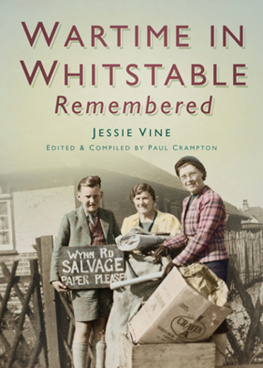CONTENTS
T his book is the second volume of my late maternal grandmother's memoirs. The first volume Dover Remembered, published by Meresborough Books in 1984, came out in her lifetime, and she therefore had complete control over every aspect of the project. (Although this book is out of print, second hand copies seem to crop up regularly in bookshops and on Internet sites). Wartime in Whitstable Remembered or, as it was originally to have been called, A Navy Wife's War Remembered, was begun by her in the late 1980s, and intended to be a logical follow-up. Sadly, my late grandfather's poor health meant that the project had to be cancelled, and although she completed a typed manuscript, the book was taken no further. My grandfather, Tom Vine, did have a small involvement in this second book, completing three drawings for it, but his contribution was nothing like that to be found in the Dover volume. My beloved Grandad passed away in July 1991, at the age of eighty-four, and the Whitstable project was put in a drawer and forgotten.
As family archivist, I later inherited all of my grandmother's photographs and manuscripts (there are at least two other unpublished, illustrated books of poetry) and the Whitstable project was among them. With the current interest in all matters concerning the Second World War, I thought it timely to pursue the publication of this forgotten second volume, and The History Press were immediately keen to take it on board, hence the book you now hold in your hands. What clinched the deal though, was the vast archive of family, and other unique photographs that I would be able to liberally spread throughout the text.
Dover Remembered covered Jessie's childhood, in her hometown, from her birth in 1907 until roughly 1920, and the aftermath of the First World War. Wartime in Whitstable Remembered picks up the story of her life again in 1939. Therefore, I thought it useful, and also of interest, to include the key events in the life of Jessie Vine (ne Tomlin) as part of this book's introduction.
The Tomlin family moved from no. 33 Trevanion Street, to no. 12 Effingham Crescent, at sometime during the 1920s. This was effectively a move across town, and also a deliberate relocation to a better area of Dover. Jessie's first job was as a window sign-writer for Woolworth's in Dover. She prospered in this endeavour and was given advancement within the organisation, which meant that she had to travel all over East Kent to other branches, including Canterbury.
Throughout this period, Jessie continued to date her childhood sweetheart, Tom, who had by now signed up for a twenty-five-year stint in the Royal Navy. Being painfully shy, he never actually called for her at no. 12, but would wait at the end of the street, until she noticed him. My grandfather's first significant ship posting was aboard HMS Cumberland, and this took him away from Jessie for months, even years at a time.
During Tom's absence, my grandmother sought alternative employment, and became a professional companion to a Mrs Du Pre, which meant her moving out of the area for the duration. The house she stayed at, when not on tour with her mistress, was Wilton Park, Beaconsfield in Buckinghamshire, which was usually referred to as the White House. This three-storey Palladian mansion had been built in 1779 by Josias Du Pre and had remained in the same family ever since. Jessie had a room on an upper storey at the front of the house, overlooking the extensive landscaped gardens.
Later on, in 1939, Wilton Park would be leased to the War Office and, by 1942, had become a prisoner-of-war camp for high-ranking enemy officers, such as Rudolf Hess. So who knows, the former Vice-Chancellor of Nazi Germany may have stayed in the same room as my grandmother once had. Sadly, the White House was demolished in 1968, to be replaced by what has been described as an ugly fifteen-storey accommodation block.
My grandmother's new career as a lady's companion wouldn't last for long, however; love was calling in the form of a young, muscular Naval rating. Tom and Jessie finally married on 11 November 1932 and they honeymooned locally. For the first few months of their marriage, the couple lived at the Tomlin family home in Effingham Crescent. Before long, Jessie again sought new employment, and this time, decided to stand on her own two feet. Having inherited many, if not all, of her father's tailoring skills (from all those many hours of watching him at work atop his bench), she decided to strike out on her own and begin a one-woman dressmaking business. Her business card read as follows, Let Jessie Tomlin make your frocks, and ensure quick service, modern styles and reasonable charges.
My grandparents subsequently found a flat in Russell Street, Dover, but a move to Rochester, in order to be nearer the dockyard at Chatham was also in the offing. This would enable my grandfather to better continue participating in the RN Barracks Field Gun Crew, which competed at Olympia every year. (Later on, as Petty Officer, or Chief Petty Officer, my grandfather would go on to train that same competitive crew.) Another tour of duty aboard HMS Cumberland subsequently beckoned, but by the time Tom came home again in early 1935, it was to a rented house in City Way, Rochester.
This was a house they shared with Tom's sister Ivy, her husband Sid Hookham (another Naval man) and their young son Bob. My mother, Joy, was born in October 1935, at the RN Hospital in Gillingham. There were terrible complications during the birth, and my grandmother very nearly died. As a result, she had to spend months in hospital afterwards and, although she mostly recovered, was not able to have any further children. In the meantime, my mother was raised by Connie Tomlin, who was the wife of Jessie's brother, Charlie. These temporary foster parents then lived in Howard Avenue, which backed on to the house in City Way. Incidentally, Joy was named after one of Colonel and Mrs Du Pre's three daughters.
A significant event in Tom's life was being given the honour of hauling the gun carriage that carried the coffin of George V at his state funeral. He was one of many such Naval ratings to have taken part, but his position was in the front row, as left-marker, because of his height and strength. The funeral took place on 28 January 1936, and the procession saw the coffin of the late king, atop a gun carriage, being taken from lying-in-state at Westminster Hall, to the funeral service at St George's Chapel, Windsor.
Even though my grandfather had become a Petty Officer by this time, for the funeral procession, he had to assume the traditional square-rig of a Naval rating. The men in front of the gun carriage had to maintain the strain and the direction of the assemblage, while those behind it acted as brake-men, preventing the carriage from running away, or the connecting ropes from slacking in the middle.
After the event, my grandfather was awarded the Royal Victorian Medal (silver) by the future Edward VIII. He was also given a commemorative photograph album, to acknowledge his service on that day, which contained a personal handwritten message from Queen Mary herself. These treasured items are still in my possession today.
Also, in 1936, Sid Hookham was posted to Malta, and took his family with him. At around the same time, Tom, Jessie and their tiny daughter Joy moved to a semi-detached bungalow at no. 9 Howard Avenue, near to where a number of relatives already resided.
By 1938 Tom was touring the world in the converted training ship HMS Vindictive, which allowed him to regularly pop-in on his sister's family in Malta. Meanwhile, back in Howard Avenue, my grandmother had her hands full with my high-spirited mother, as she became an active toddler.









